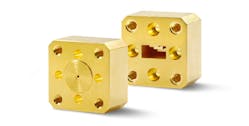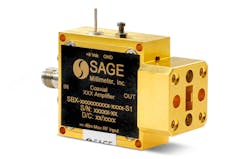Millimeter-wave (mmWave) frequencies are receiving a great deal of attention these days, with 5G obviously being a major catalyst. One firm right at the forefront of mmWave technology is SAGE Millimeter, which had some new toys to show off at the recent IMS 2019.
At the exhibition, SAGE unveiled its patent-pending Uni-Guide waveguide connectors (Fig. 1). The company asserts that the Uni-Guide waveguide connectors are revolutionary products because they eliminate the need for waveguide-to-coax adapters as well as dedicated packages with built-in waveguide transitions.
1. With Uni-Guide waveguide connectors, standard waveguide interfaces can be created from standard coaxial glass bead pins.
Figure 2 shows how a Uni-Guide waveguide connector can directly replace a coaxial connector to form a waveguide interface. With these connectors, a standard waveguide interface is created from the standard coaxial glass bead pin. Hence, the Uni-Guide connectors give customers a standard waveguide interface that doesn’t require any mechanical modifications.
2. The Uni-Guide connectors allow for direct replacement of coaxial connectors.
The Uni-Guide connectors also offer the flexibility to allow for various orientations. For example, Figure 2 depicts a vertically aligned connector, but the connectors can be horizontally aligned by simply rotating them 90 degrees (Fig. 3).
3. Shown is a horizontally aligned Uni-Guide connector.
In terms of benefits, SAGE Millimeter says that “the Uni-Guide waveguide connector can reduce product development cycle time, eliminate additional design costs, and minimize additional inventory management. Instead of developing various custom waveguide interfaced packages to satisfy different frequency bands and waveguide-orientation requirements, only a few standard housings and waveguide connectors are needed to accommodate many package variations.”
Three Uni-Guide connectors are currently offered: the SUF-1912-480-S1, SUF-2212-480-S1, and SUF-2812-480-S1. All three are interchangeable with standard two-hole coaxial connectors with a mounting hole separation of 0.48 inches along with a 12-mil diameter pin.
The SUF-1912-480-S1 is a WR19 waveguide connector that covers a frequency range of 40 to 60 GHz. It achieves a typical insertion loss of 0.7 dB.
The SUF-2212-480-S1 and SUF-2812-480-S1 are WR22 and WR28 waveguide connectors, respectively. The SUF-2212-480-S1 connector spans a frequency range of 33 to 50 GHz and achieves a typical insertion loss of 0.6 dB.
The SUF-2812-480-S1 covers a frequency range of 26.5 to 40.0 GHz. It attains a typical insertion loss of 0.5 dB.
In addition to the Uni-Guide waveguide connectors, SAGE Millimeter unveiled its 1.35-mm (E) connector products. These devices allow for an efficient transition between rectangular waveguide interfaces and 1.35-mm (E) coaxial connector environments. Customers can choose either end-launch or right-angle versions.




